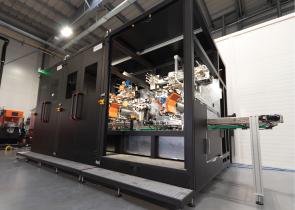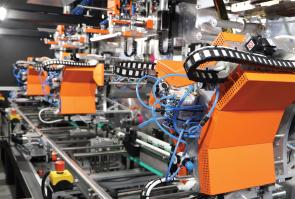CC-Link IE TSN drives innovation in Keller’s industrial printing technologies
Keller, a leading OEM of machines that perform screen and pad printing as well as hot stamping based in Poland, has developed an innovative new system that leverages CC-Link IE TSN network technology to boost productivity. By incorporating Time-Sensitive Networking (TSN), the new bottle printing machine delivers next level productivity via deterministic motion control over a multitude of servos. This has resulted in significant improvements in terms of performance, accuracy and precision.
Printing and stamping are among the most demanding motion control applications, as they use multiple axes that need high levels of synchronisation to operate effectively at extraordinary speed with high repeatability. When looking at their communications requirements, these functions need to be supported by highly deterministic, real-time communications across multiple axes. At the same time, end users are demanding ever-more high-speed, advanced machines, meaning that implementing a network technology that can achieve this is key. TSN is the technology that can address these requirements today, while also offering further benefits for the future. These include the possibility of using a converged network architecture to simplify machine design, reduce costs and decrease time to market. This is enabled by multiple kinds of traffic being combined together, rather than using separate networks as in the past.
In its drive to serve the market with state-of-the-art printing technologies, Keller was keen to adopt the most promising, innovative automation devices and industrial communications solutions. When Keller wanted to develop a universal, modular machine for direct, multi-colour printing on cylindrical goods, such as bottles, it turned to its longstanding partner, and board member of the CC-Link Partner Association (CLPA), Mitsubishi Electric. The team at the heart of the collaboration set out to identify the most suitable options from which it could create the best machine to support Keller’s ambitions and the needs of its customers.
Tomasz Andrzejewski, Head of Automation Department at Keller, explains: “We started cooperating with Mitsubishi Electric in 2012. Since then, we have been able to appreciate and experience first-hand the abilities of Mitsubishi Electric’s solutions, including its latest generation of servos. These are incredibly reliable and meet our strict precision requirements.”
Taking the right turn
The unique setup developed by the companies, which combines screen printing and hot stamping on cylindrical objects, utilises an industrial automation system that incorporates CC-Link IE TSN network technology to offer ground-breaking performance. This includes MELSEC MR-J5 servos controlled by an iQ-R series PLC.
As a key supporter of CC-Link IE TSN, Mitsubishi Electric used the network’s industry leading combination of TSN and gigabit bandwidth to offer Keller a system that could provide fully deterministic control of up to 128 axes. It also enabled extreme synchronisation accuracy in the order of microseconds. This ensures that the machine can deliver prints of consistently high quality while maintaining a rate of 3,000 units per hour, with a plan to reach 3,600.
Michal Cydzik, Product Manager for Control Systems at Mitsubishi Electric, adds: “What Keller wanted was a really advanced and ambitious setup, with 20 axes per colour head and a total of 65 MR-J5 drives, in addition to 18 auxiliary virtual axes. CC-Link IE TSN provided the necessary determinism, capacity and bandwidth required to handle this while delivering the performance Keller needed.”
Opening the door to future-oriented manufacturing
The resulting machine offers end users a modular, versatile solution that delivers enhanced productivity, cost-effectiveness, flexibility and high print quality. Moreover, the setup is scalable, as it can incorporate up to 8 different colours (and their necessary axes) and is completely reconfigurable. It can be extended to include additional printing modules to deliver a highly integrated system. The final result was an industry leading machine which was enabled by an equally industry leading open industrial Ethernet technology.
John Browett, General Manager at CLPA Europe, comments: “We are really pleased to see how Keller took the capabilities of CC-Link IE TSN and used them to develop a system that will allow them to remain at the leading edge of their industry. We know how capable the technology is, and it’s very rewarding to see how they fully exploited it to achieve a high productivity solution for their customers. They have also identified the convergent network architecture benefits that TSN can deliver for future development and plan to add additional machine functions like vision systems on the same network architecture. This will further demonstrate how these features can simplify machine design, reduce costs and decrease time to market.
“Keller is an excellent example of how CC-Link IE TSN can drive next-level performance and capabilities in key industries. Market acceptance continues to grow and there are currently a wide variety of industries and applications where it is in use. This attests to the strength of our latest technology and its increasing global importance.”


- Association de Partenaires CC-Link (CLPA)
Espace membre 



